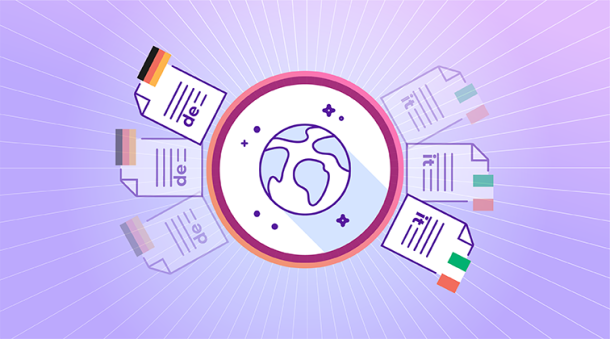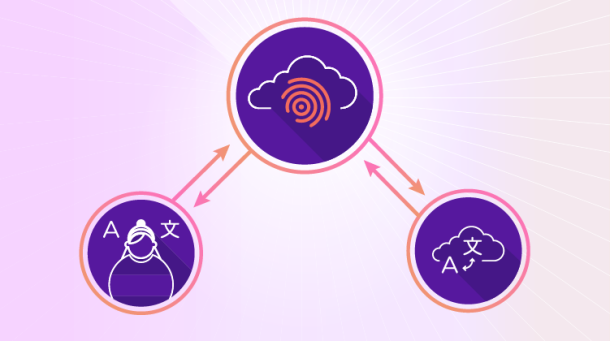75% of the population will choose the product offered in their native language.
And since less than a third of the nearly 4 billion people on the Internet speak English as their native language (even in English-speaking countries), that means any brand looking to expand globally needs to think about translating their content.
40% of businesses don’t use localization. It’s time to zig when everyone is zagging.
Hiring professional localization services isn’t just a nice-to-have anymore, especially if you want to compete globally. If you want to deliver a best-in-class customer experience for your customers—no matter where they’re purchasing from you—then you need to think about more than just translation.
Localization is the process of adapting the full meaning of a piece of content for a new region, including translation, associated imagery, and cultural elements that influence how your content is perceived. Fully localized content resonates with users because it incorporates relevant cultural nuance to feel familiar instead of simply replacing English words with translated text.
5 reasons to work with localization services (and what to expect)
Doing this for multiple languages gets complex quickly.
Here’s why using localization services can save you plenty of headaches (and what kind of results you can expect from some of our customers!):
1. All-in-one with professional language services
The most challenging aspect of localization? Scalability.
Even if you have a bare-bones website or app, you’ve got more content than you think. And you’re continuously updating that content, writing additional articles, launching more landing pages, adding new features … add that to the fact that it takes almost 52 languages to reach the majority of the global audience, and you’ve got a headache waiting to happen.
That’s why Smartling uses both software services and language services to simplify the complexities inherent in global content. Our software automates the process around human translation so you can automatically manage it all in one place, with a comprehensive system of record for all things global content, from your e-commerce checkout flow to your website.
Localization involves so much more than translation— you’re not just able to add more languages to your website, but also make sure your messaging, images, and assets work in your target markets, too.
“We wanted our own set of tools to manage our workflow, staffing, and performance, particularly around security, code integrity, and page delivery. After connecting with Smartling, we saw that their philosophy and technology were so sophisticated, advanced, and complementary to our own that we decided to engage with them instead. We've never looked back.” — Nina Yiamsamatha, Marketing Manager at Foursquare
2. Streamline the localization process for website localization and beyond
Traditional localization processes look like this:
- The content owner exports all of the content or code into a spreadsheet and emails it to their language services provider
- The agency then emails that spreadsheet to, say, 10 different translators for 10 different language requests
- The translators complete their work and send it back to the agency, who compiles all 10 files into one
a. ...which turns into a gigantic, scary-looking spreadsheet with English in the first column and every string representing a different row. 4. This large file gets emailed back to the client, who then has to import each string into the content management system (CMS) or engage with their developers to manually code the strings into the website or app.
That takes a lot of turnaround time and effort, and if there’s an error, it’s unlikely you’d know until it’s way too late. Every marketing or web team has its own process, whether it’s a specific sprint cadence or homegrown CMS tool. You may want your legal team to look at the final product or work with internal designers to make sure the new text works well on desktop and mobile.
This is why we work with teams around the world to customize their localization process. Here’s how this process works with Smartling:
- Smartling automatically integrates with your content management system, so anytime there are updates or new content, it’s automatically parsed into strings and sent to a translator.
- Your assigned translators complete the work, tracking their progress and communicating directly with you throughout in case there are any questions.
- When the translations are all set, it automatically goes back into your CMS, and you click Publish.
That’s it.
“We were able to launch our new AdRoll Group website in 7 languages within just two weeks! Smartling's Managed Services team acted as our localization manager, coordinating translation deliveries and communicating with vendors. Since we started using Managed Services, we've more than halved the time we spend each week managing localization projects.” — Gavin Flood, Senior Director of Marketing, EMEA & APAC, AdRoll
3. Ensure high-quality translations for app localization and more
Technically correct is not good enough. The quality of your content is your brand.
Typical translation processes rely on grammatically correct options that, while understandable, won’t make your brand persuasive or relatable. It’s even more important for content-heavy brands for e-learning or multimedia content.
Instead, translators can use transcreation to maintain the spirit of your message while introducing culturally relevant references. With Smartling, you know the translator and they know your organization. They can help you execute a specific tone and voice designed to carry your brand globally.
With localization services, you also get unparalleled quality assurance. Robust translation memory, glossaries and style guides, and visual context give translators more information so they can deliver high-quality translations the first time.
Smartling’s automation also prevents other formatting errors, like typos, broken placeholders, or pieces of code that could ruin your user experience. You can set rules ahead of time that automatically reject a translation if certain errors are introduced. Your developers can rest easy for your software localization and more.
“We ended up getting on a call with Smartling’s Japanese translator and translation service team to talk through our preferences for Japanese content. This isn’t normal for the industry, having the ability to speak directly with the translator; I was so impressed.” — Jessica Birenz, Director of Planning and Project Management at Yext
Read how Smartling helped Yext translate 12 million words to support teams around the world.
4. Integrate with the rest of your technology
Localization services must be able to integrate with your source content, and automate the professional translation workflow.
Whether it’s making sure you can seamlessly use your content management system like HubSpot or Marketo, design tools like Sketch or Illustrator, web development tools like Github, or customer support tools like Zendesk, integrations and APIs are what make streamlining the localization process possible.
Localization doesn’t have to be an all-consuming process that takes you from one language to a target language. With technology integrations, you can manage your translation efforts without sending a single email, touching any button, or managing strings in spreadsheets.
“Smartling’s end-to-end solution and data-driven approach to localization integrates with our AEM instance, saving us time and resources when updating in-language content and adding support for new markets.” — Chris Hamilton, Director of Digital Experience, Marketing & Channels Applications, IHG
5. Make data-driven decisions about your go-to-market strategy
With translation, you’re often operating in the dark.
Localization is a key part of your global go-to-market strategy. Without understanding how your translations and content perform, you won’t be able to make effective decisions about further expansion, engagement, or resources. A few key metrics you’ll want to track are:
- Page view count: If view counts don’t show an increase after translation, you may want to examine other aspects of your localization plan. A straight translation may not be enough to engage consumers in the global market. For example, effective keyword choices can vary in different languages, so it’s important to make sure they are targeted locally to maximize their visibility among search engines.
- App downloads: To determine the ROI on localization services or translating your mobile apps, compare the number of app downloads from a specific local market before and after creating a localized app. If your translated app has direct purchasing options or in-app downloads, you can analyze that data as well.
- Engagement: Keep track of content and website shares—as well as mentions of your brand on social networks like Facebook and Twitter—before and after translation to determine if there is an increase in interest among the local markets you are targeting.
- Consumer growth and retention: When in doubt, go directly to the source after your content is translated. Take a look at consumer reviews of your company, or use direct contact to poll new and long-time visitors on their level of satisfaction.
- Revenue: Although an increase in actual sales is not the only way to identify when your localization efforts are catching on in new markets, it’s certainly an important factor. If your revenue increases in local markets after translation, it’s a good sign.
“Being able to deliver a new language on ba.com in half the usual time enabled us to go live to coincide with our first flight to Korea.” — Geraint Jones, former Digital Content Production Manager at British Airways
Why work with localization services?
Localization doesn’t have to be complex, “good enough,” or without data. Localization services like Smartling give you one comprehensive solution for all of your translation needs, with the flexibility to include human translation, machine translation, or both.
Our white-glove project management and automation make localization easy.
Don’t settle for good enough. Try Smartling today.






